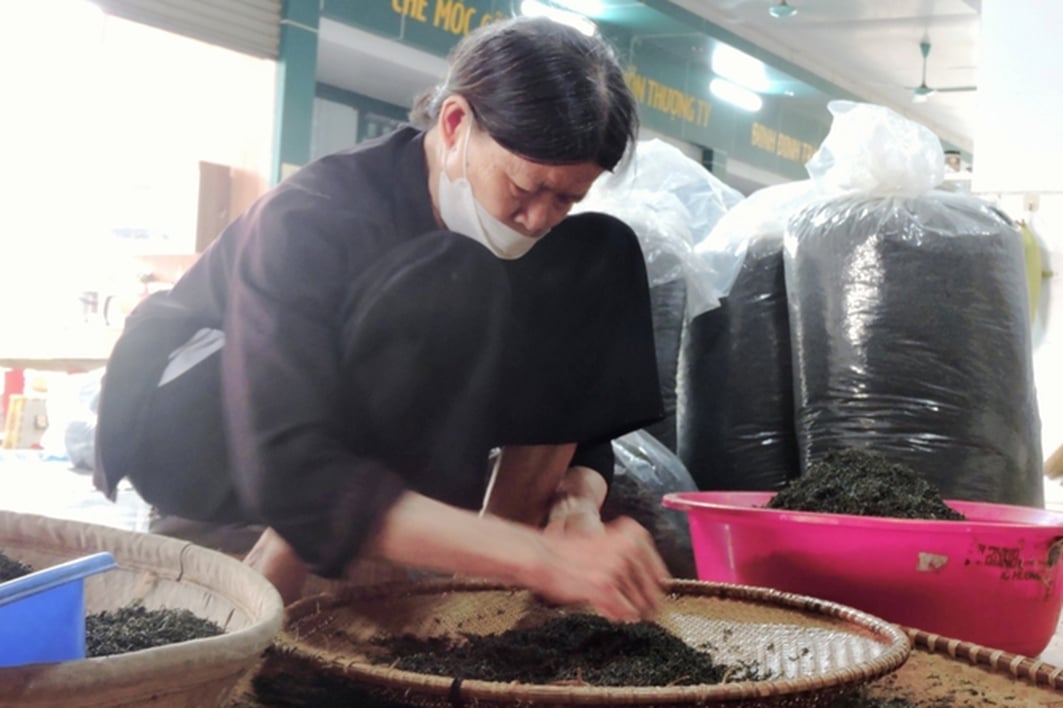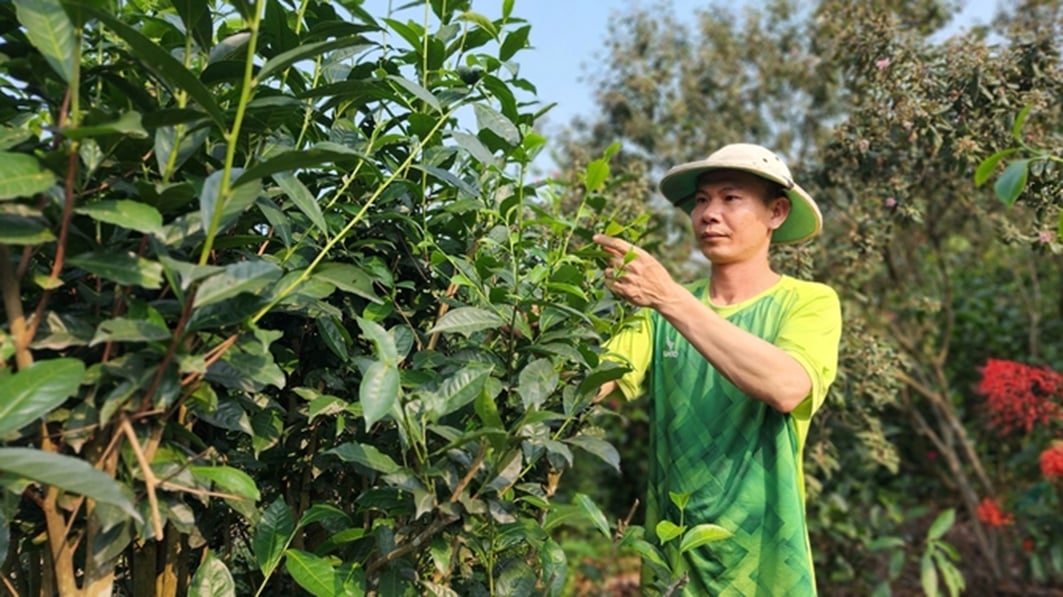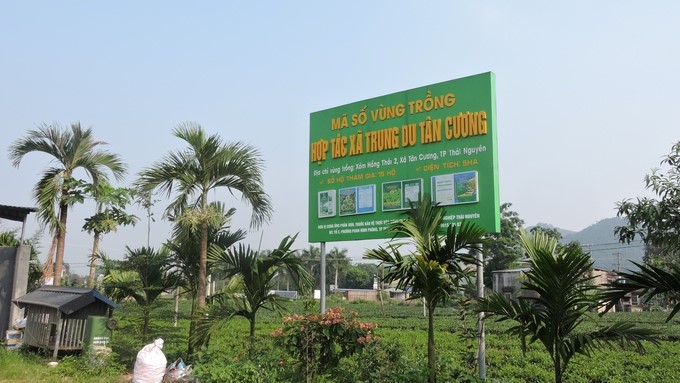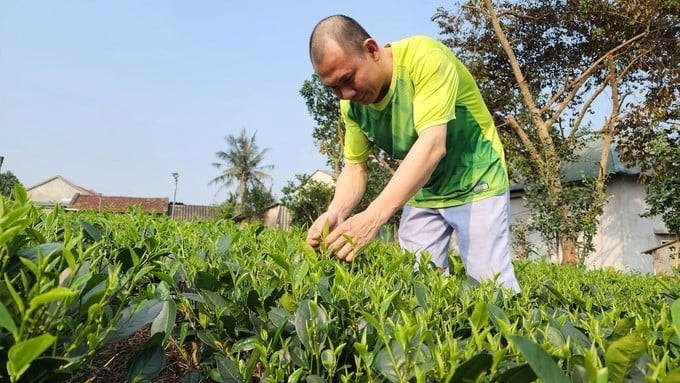June 21, 2025 | 01:10 GMT +7
June 21, 2025 | 01:10 GMT +7
Hotline: 0913.378.918
June 21, 2025 | 01:10 GMT +7
Hotline: 0913.378.918

Tan Cuong tea artisans. Photo: Hoang Anh.
The Tan Cuong commune official took me to Hong Thai village, looked for the house of Mr. Le Quang Nghin, and said that the oldest remaining Tan Cuong tea tree was in that house, and that house was also the oldest tea-making household.
The first tea harvesting season in Tan Cuong begins in January on the lunar calendar, when the spring weather is cool and mild on the hills. That's when the tea gardens, which had endured the torment of frost all winter, met the gentle spring sunshine and rushed to pop the buds. The fresh green buds sprout like billions of sharp cyan nails reaching out in the golden sunlight, called "Fortune of Heaven." Mr. Nghin picked the young tea buds that still had the morning dew on them and brought them to his mouth to sip while telling us interesting stories about the tea profession in Tan Cuong.
Compared to several hundred households living with the tea profession in the commune, Mr. Nghin's origin is somewhat special. His family, a rare group of people who are not originally from Hung Yen, Nam Dinh, or Thai Binh and are said to be from the Ngai ethnic group in Lang Son, migrated here before the group of soldiers. Mr. Nghin was told by the old people that the wandering trip in 1918 of that group of Ngai people initially consisted of hundreds of people and was divided into two directions. A branch went to the Lo River in Tuyen Quang and Phu Tho and was later washed away by floodwater without leaving any trace. Another branch led us to live in the middle of today’s Tan Cuong Old Forest. Over the years, there have been more than a dozen households, all of them in the tea profession.

An ancient tea tree in Mr. Le Quang Nghin's garden. Photo: Toan Nguyen.
The ancient tea tree in front of Mr. Nghin's yard has been there since 1928. That was the time when Mr. Doi Nam divided tea seeds among several households in Tan Cuong to plant. Each of Mr. Tuong Nghiem, Mr. Cuong Nhung, Mr. Trum Ty, etc. occupied a few hills. In those days, tea was planted in a forest without cutting branches like today and just letting it grow naturally. After decades of years, each tree had a stump as big as a thermos and a canopy as wide as a large flat basket, sitting under the rain without getting wet and indistinguishable from the forest when looking far away. Until the period of cooperation, the tea farming land was paid to the state. Several decades later, the cooperative disbanded, and the land was delegated to the people.
It was also a period of many fluctuations in the tea profession. The old-fashioned farming method had low productivity. In 1979, there was a border war, and the Chinese side stopped providing tea-firing technology, so the traditional tea industry gradually disappeared.

Director of Tan Cuong Midland Tea Cooperative. Photo: Hoang Anh.
Farewell to the able man Le Quang Nghin, we came to Mr. Nguyen Thanh Duong, Director of Tan Cuong Midland Tea Cooperative and the first person to participate in the “Project on Conservation and Development of Midland Tea Varieties to Preserve and Develop Tan Cuong Geographical Indication.”
As a person who is immersed in traditional values, especially for ancient tea varieties and the hundred-year-old tea profession in Tan Cuong, the director of the cooperative with An Duong Tra brand sometimes complains that even though Tan Cuong tea has been celebrated as the “first famous tea”, the honor for Tan Cuong tea is still not worthy compared to its quintessential value. The quintessence here is the hands and brains of the workers. The tea-making profession is inherently hard work, but it is from that hard look that the value and talent of the working hands of the Tan Cuong people are revealed to the maximum.
Mr. Duong's Tan Cuong midland tea cooperative was established in 2018 with eight members, 75 affiliated households, and an area of more than 20ha. In addition to the perennial midland tea hill of Mr. Nghin's family, this cooperative is the place with the largest area of tea varieties that make up the name Tan Cuong.
"The specialty tea area now mainly grows two main varieties: the LDP1 hybrid tea variety and the traditional midland tea variety. Making high-class teas is mainly based on these two varieties; the rest, such as Bat Tien and Kim Tuyen varieties, are now not grown anymore," Mr. Duong revealed.

Tan Cuong Midland Tea Cooperative. Photo: Hoang Anh.
The cooperative with the An Duong Tra brand pioneered building high-class tea products to serve upper-class customers, such as high-class Tan Cuong midland Dinh tea, Tan Cuong tea marinated with West Lake lotus, Tuoc Thiet Tan Cuong tea, the King’s tea, etc. Mr. Duong's desire is to make Tan Cuong specialty teas that can't be found anywhere else. For example, Tuoc Thiet tea is currently being made by the cooperative.
It's the kind of tea that, right from the selection of raw materials, has been different. The tea variety used to make Tuoc Thiet tea must be a midland variety grown on hills with a slope of no more than 30%. The hilly land must be gravel soil mixed with ruby stone, which is unique to the Tan Cuong region. The soil drains very quickly when it is rainy, but retains moisture when it is sunny, like an air conditioner that helps tea plants grow best.
The process of taking care of this high-class tea is also very special. In addition to organic fertilizers and probiotics, each cycle of the tea tree is cared for with a nutritious mixture of honey, chicken eggs, and milk so that until harvesting time, all the essence of the tea tree concentrates on the bud.

Traditional midland tea variety in Tan Cuong. Photo: Van Viet.
The process of harvesting must be completely handcrafted, with plucking at dawn when the dew is still on the tea buds. And also select the highest tea nails on the tea tree to pick. To make it easy to imagine, among high-class Dinh teas currently selling for VND 5-8 million with only the nail part of the tea tree, only 40% of those nails were selected to make Tuoc Thiet tea.
The tea plucking people must have the right technique; ten tea nails must be the same. Not plucking them up and putting them in the basket as usual, but gently putting them in porcelain bowls. Just the cut of the tea nail is not definitive, or if it is a little bruised, it will be removed immediately. Meticulous and very time-consuming, so the wages for harvesting alone have reached millions of dong per kilogram of fresh. Everything is twice as expensive as Dinh tea, so the price of Tuoc Thiet tea is also double.
According to Mr. Duong, the quality of Tan Cuong tea can be completely "raised to the highest pinnacle", so there is no reason why we have to adore tea from other countries.
"The ancient midland tea variety grown from seeds has a longer lifetime and more nutrition, but it is difficult to make and not productive. Before 2010, people dug all of them up to switch to growing hybrid tea. The old tea hill has been scooped up by machines. Only this tree remains. " When Mr. Hau A. Lenh, Minister and Chairman of the Committee for Ethnic Affairs, came to visit, he regarded it as a precious treasure with the necessary name attachment to preserve it," said Mr.Nghin.
Translated by Huyen Vu Thu
/2025/06/17/3942-2-143243_548.jpg)
(VAN) Recently, in Sweden, the Secretary of the Binh Dinh Provincial Party Committee presented the Investment Registration Certificate for the 'Polyester Fabric Recycling Complex' project to SYRE Impact-AB Company.
/2025/06/12/3721-2-202745_83.jpg)
(VAN) TH made an impression at Seoul Food 2025 with its line of natural beverages, paving the way for Vietnamese food products to enter the South Korean market.

(VAN) Soc Trang's success in rice exports stems from a strategy of developing fragrant and specialty rice cultivation areas and standardizing production toward low-emission practices.
/2025/06/11/1311-5-120811_839.jpg)
(VAN) The pig farming industry is facing the challenge of comprehensive restructuring to meet requirements for quality, safety, traceability, and market expansion both domestically and for export.

(VAN) Vietnam considers participating in ALGROALBA in order to expand agricultural production, coordinate the assessment and effective exploitation potential land.
/2025/06/05/5314-1-184727_407.jpg)
(VAN) From seemingly worthless fish scales and skin, enzymes and lactic ferments can transform by-products into peptides, opening a sustainable, effective business direction and elevating Vietnamese seafood.

(VAN) TTC AgriS and IFC signed a strategic partnership to develop a sustainable agricultural value chain, aiming to achieve the Net Zero target by 2035.